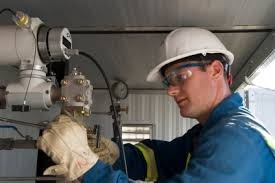Machine Safety

Machines can assist in improving production efficiency in the workplace. However these machines have moving parts, sharp edges, and hot surfaces with the potential to cause severe workplace injuries such as crushed fingers or hands, amputations, burns, or blindness. Safeguards are essential for protecting workers from these preventable injuries. Any machine part, function, or process that might cause injury must be safeguarded. When the operation of a machine may result in a contact injury to the operator or others in the vicinity, the hazards must be eliminated or controlled.
The NIOSH High Bay Laboratory contains a 37-foot high ceiling with an overhead catwalk and is dedicated to research efforts in reducing fall-related injuries, as well as improving the safety of large equipment used in industrial, construction and agricultural applications. Test equipment in this laboratory includes a 5-ton bridge crane, a test bed, an MTS hydraulic power supply and actuator system, and a research manikin. The hydraulic actuators can produce up to 20,000 pounds of force. The Advanced Dynamic Anthropomorphic Manikin (ADAM) is representative of a 95th percentile Air Force male. ADAM contains a sophisticated and ruggedized onboard data acquisition system, joints sensors, three tri-axial accelerometers (located in the head, chest, and lower torso), and two load cells (located at the neck and lower spine). The catwalk equipped with protective rails provides a mechanism for studying human perception and responses at elevations. The laboratory, which was developed in 1995, has been used for an array of projects, such as improving scaffolding stability, ladder safety, design of tractor roll over protective structures, tension/compression testing of fabricated protective structures, and ingress/egress safety for construction equipment. The ADAM has been used in a series of tests on the biodynamic forces that protective equipment and the human body would experience during free-fall and rapid deceleration while wearing fall-restraint equipment.
The Safety Engineering Laboratory is the focal point for pilot testing of instrumentation and study procedures for field-based safety engineering studies. It currently consists of several pieces of equipment used for cab design and reverse engineering. Two FARO arms (6-foot and 8-foot) along with two test bucks (one to simulate a long haul truck cab and the other to simulate a fire engine cab) have been used to measure cab accommodation for individual subjects. Both test bucks have all major cab operational components, including the clutch, brake, accelerator, gear shift, steering wheel, side-view mirrors, and driver’s seat; all of which can be adjusted to fit a specific subject. Previously tested study procedures include developments of ambulance impact tests for emergency medical service personnel safety, field evaluation of fall risks among roofing workers, paper baler jam alert system testing, slip-trip-and-fall risk assessment in healthcare settings, field testing of farm tractor roll-over protective volume, and design of improved truck cabs for safer truck operation.
- 2k28f980d757e2a294dbf3da96b31d6d88.jpg
The NIOSH High Bay Laboratory contains a 37-foot high ceiling with an overhead catwalk and is dedicated to research efforts in reducing fall-related injuries, as well as improving the safety of large equipment used in industrial, construction and agricultural applications. Test equipment in this laboratory includes a 5-ton bridge crane, a test bed, an MTS hydraulic power supply and actuator system, and a research manikin. The hydraulic actuators can produce up to 20,000 pounds of force. The Advanced Dynamic Anthropomorphic Manikin (ADAM) is representative of a 95th percentile Air Force male. ADAM contains a sophisticated and ruggedized onboard data acquisition system, joints sensors, three tri-axial accelerometers (located in the head, chest, and lower torso), and two load cells (located at the neck and lower spine). The catwalk equipped with protective rails provides a mechanism for studying human perception and responses at elevations. The laboratory, which was developed in 1995, has been used for an array of projects, such as improving scaffolding stability, ladder safety, design of tractor roll over protective structures, tension/compression testing of fabricated protective structures, and ingress/egress safety for construction equipment. The ADAM has been used in a series of tests on the biodynamic forces that protective equipment and the human body would experience during free-fall and rapid deceleration while wearing fall-restraint equipment.
- 2i410d44c93a335deddd960a291e8a15b8.jpg
The Safety Engineering Laboratory is the focal point for pilot testing of instrumentation and study procedures for field-based safety engineering studies. It currently consists of several pieces of equipment used for cab design and reverse engineering. Two FARO arms (6-foot and 8-foot) along with two test bucks (one to simulate a long haul truck cab and the other to simulate a fire engine cab) have been used to measure cab accommodation for individual subjects. Both test bucks have all major cab operational components, including the clutch, brake, accelerator, gear shift, steering wheel, side-view mirrors, and driver’s seat; all of which can be adjusted to fit a specific subject. Previously tested study procedures include developments of ambulance impact tests for emergency medical service personnel safety, field evaluation of fall risks among roofing workers, paper baler jam alert system testing, slip-trip-and-fall risk assessment in healthcare settings, field testing of farm tractor roll-over protective volume, and design of improved truck cabs for safer truck operation.
- h257bd6d91d6cc3452b31aaecb5c86d8da.jpg